On the Theoretical Conceptualisations, Knowledge Structures and Trends of Green New Deals
Abstract
:1. Introduction
2. Surveying Green New Deals
3. Methods
4. Results and Discussions
4.1. Countries Making the Most Contributions
4.2. Most Influential Organisations
4.3. Most Influential Journals
4.4. Most Influential References
4.5. Most Influential Authors
4.6. Term Co-Occurence
4.6.1. All Periods
4.6.2. First Period (1995–2014)
4.6.3. Second Period (2015–2019)
4.6.4. Third Period (2020–2021)
5. Conclusions
Author Contributions
Funding
Institutional Review Board Statement
Informed Consent Statement
Data Availability Statement
Conflicts of Interest
References
- Davies, R. Western Europe—Storms Case Floods in Switzerlnd, Germany and UK. Available online: https://floodlist.com/europe/storms-floods-switzerland-germany-uk-july-2021 (accessed on 10 August 2021).
- Inman, E.N.; Hobbs, R.J.; Tsvuura, Z. No safety net in the face of climate change: The case of pastoralists in Kunene Region, Namibia. PLoS ONE 2020, 15, e0238982. [Google Scholar] [CrossRef] [PubMed]
- Chiang, F.; Mazdiyasni, O.; AghaKouchak, A. Evidence of anthropogenic impacts on global drought frequency, duration, and intensity. Nat. Commun. 2021, 12, 2754. [Google Scholar] [CrossRef] [PubMed]
- UNEP. Emerging Issues for Small Island Developing States; UNEP: Nairobi, Kenya, 2014. [Google Scholar]
- IPCC. The Physical Science Basis. Contribution of Working Group I to the Sixth Assessment Report of the Intergovernmental Panel on Climate Change; Cambridge University Press: Cambridge, UK, 2021; in press. [Google Scholar]
- Intergovernmental Panel on Climate Change. Global Warming of 1.5 °C: An IPCC Special Report on the Impacts of Global Warming of 1.5 °C Above Pre-Industrial Levels and Related Global Greenhouse Gas Emission Pathways, in the Context of Strengthening the Global Response to the Threat of Climate Change, Sustainable Development, and Efforts to Eradicate Poverty. Intergovernmental Panel on Climate Change. 2018. Available online: https://www.ipcc.ch/site/assets/uploads/sites/2/2019/05/SR15_SPM_version_report_LR.pdf (accessed on 1 September 2021).
- UNFCCC. Nationally determined contributions under the Paris Agreement: Synthesis report by the secretariat. In Proceedings of the Conference of the Parties Serving as the Meeting of the Parties to the Paris Agreement, Glasgow, Scotland, 17 September 2021. [Google Scholar]
- United Nations Framework Convention on Climate Change. Synthesis report on the aggregate effect of the intended nationally determined contributions. In Proceedings of the Report of the Ad Hoc Working Group on the Durban Platform for Enhanced Action, Paris, France, 30 October 2015; p. 66. [Google Scholar]
- Shan, Y.; Ou, J.; Wang, D.; Zeng, Z.; Zhang, S.; Guan, D.; Hubacek, K. Impacts of COVID-19 and fiscal stimuli on global emissions and the Paris Agreement. Nat. Clim. Chang. 2021, 11, 200–206. [Google Scholar] [CrossRef]
- UNEP. Are We on Track for A Green Recovery? Not Yet. Available online: https://www.unep.org/news-and-stories/press-release/are-we-track-green-recovery-not-yet (accessed on 20 September 2021).
- United Nations Development Programme (UNDP). Sustainable Development Goals; UNDP: Geneva, Switzerland, 2015; p. 24. [Google Scholar]
- Le Quéré, C.; Peters, G.P.; Friedlingstein, P.; Andrew, R.M.; Canadell, J.G.; Davis, S.J.; Jackson, R.B.; Jones, M.W. Fossil CO2 emissions in the post-COVID-19 era. Nat. Clim. Chang. 2021, 11, 197–199. [Google Scholar] [CrossRef]
- The European Commisision. Circular Economy Action Plan: For a Cleaner and More Competitive Europe; European Union: Luxembourg, 2020; p. 28. [Google Scholar]
- Congress. 116th Congress 1st Session: H. RES. 109. 2019. Available online: https://www.congress.gov/bill/116th-congress/house-resolution/109 (accessed on 1 September 2021).
- European Commission. The European Green Deal: Questions & Answers. Available online: https://ec.europa.eu/commission/presscorner/detail/en/QANDA_19_6690 (accessed on 23 February 2021).
- Conte, N. Green New Deal. Available online: https://wtpartnership.co/green-new-deal/ (accessed on 24 February 2021).
- UN. Green Economy. Available online: https://sustainabledevelopment.un.org/index.php?menu=1446 (accessed on 2 September 2021).
- Mastini, R.; Kallis, G.; Hickel, J. A Green New Deal without growth? Ecol. Econ. 2021, 179, 106832. [Google Scholar] [CrossRef]
- Dercon, S. Is Green Growth Good for the Poor? University of Oxford: Oxford, UK, 2011. [Google Scholar]
- Daniels, R.; Franklin, D. Roosevelt: Road to the New Deal, 1882–1939; University of Illinois Press: Illinois, IL, USA, 2018. [Google Scholar]
- Atkin, E. The Democrats Stole the Green Party’s Best Idea. Available online: https://newrepublic.com/article/153127/democrats-stole-green-partys-best-idea (accessed on 23 February 2021).
- Bloomfield, J.; Steward, F. The Politics of the Green New Deal. Political Q. 2020, 91, 770–779. [Google Scholar] [CrossRef]
- Google Trends. Green New Deal: 2004 to 2021. Available online: https://trends.google.com/trends/explore?date=all_2008&gprop=news&q=%27green%20new%20deal%27 (accessed on 29 August 2021).
- Google Trends. Green New Deal. Available online: https://trends.google.com/trends/explore?date=all_2008&gprop=images&q=green%20new%20deal (accessed on 29 August 2021).
- Donato, D. The Green New Deal and China’s Green Revolution. Available online: https://www.peoplesworld.org/article/the-green-new-deal-and-chinas-green-revolution/ (accessed on 25 August 2021).
- Chatzky, A.; Siripurapu, A. Envisioning a Green New Deal: A Global Comparison. Available online: https://www.cfr.org/backgrounder/envisioning-green-new-deal-global-comparison (accessed on 25 August 2021).
- MacArthur, J.L.; Hoicka, C.E.; Castleden, H.; Das, R.; Lieu, J. Canada’s Green New Deal: Forging the socio-political foundations of climate resilient infrastructure? Energy Res. Soc. Sci. 2020, 65, 101442. [Google Scholar] [CrossRef]
- London Assembly. A Green New Deal. Available online: https://www.london.gov.uk/coronavirus/londons-recovery-coronavirus-crisis/recovery-context/green-new-deal (accessed on 25 August 2021).
- Chowdhury, S. South Korea’s Green New Dealinthe year of transition. Available online: https://www.undp.org/blogs/south-koreas-green-new-deal-year-transition (accessed on 24 August 2021).
- Paszak, P. The Chinese Vision of the Green Deal. Available online: https://ec.europa.eu/clima/sites/default/files/international/cooperation/china/docs/zhong_ou_he_zuo_yan_jiu_bao_gao_-20201128_en.pdf (accessed on 24 August 2021).
- Moreno-Brid, J.C.; Gallagher, K. Mexico’s Road to a Green New Deal. NACLA Rep. Am. 2020, 52, 152–157. [Google Scholar] [CrossRef]
- Government of Singapore. Introducing the Green Plan. Available online: https://www.greenplan.gov.sg/key-focus-areas/overview (accessed on 28 August 2021).
- Gunia, A. Could the World’s Largest Green Energy Hub Redefine How Companies Work with Indigenous People? Available online: https://time.com/6080182/australia-green-energy-aboriginal-people/ (accessed on 22 September 2021).
- Visentin, L. ‘Massive Green Deal’: NSW Environment Minister Spruiks $2 Billion Energy Package. Available online: https://www.smh.com.au/politics/nsw/massive-green-deal-nsw-environment-minister-spruiks-2-billion-energy-package-20200131-p53wgg.html (accessed on 20 September 2021).
- The Climate Mobilization. About. Available online: https://www.theclimatemobilization.org/about/ (accessed on 25 August 2021).
- Green Party. The Green New Deal. Available online: https://www.gp.org/green_new_deal (accessed on 23 August 2021).
- The Greens/EFA. The Green New Deal: More than a Policy, a Programme for Living. Available online: https://www.greens-efa.eu/en/article/document/the-green-new-deal (accessed on 23 August 2021).
- DiEM25. The Green New Deal for Europe. Available online: https://diem25.org/campaign/green-new-deal/ (accessed on 23 August 2021).
- Green Party of the United States. The Green New Deal. Available online: https://gpus.org/organizing-tools/the-green-new-deal/ (accessed on 25 August 2021).
- French, H.; Renner, M.; Gardner, G. Toward a Transatlantic Green New Deal: Tackling the Climate and Economic Crises; Heinrich-Böll-Stiftung: Brussels, Belgium, 2009; Volume 3. [Google Scholar]
- League of Conservation Voters (LCV). LCV Supports Green New Deal Resolution. Available online: https://www.lcv.org/article/lcv-supports-green-new-deal-resolution/ (accessed on 22 August 2021).
- New Economics Foundation. Green New Deal: Cutting Carbon Emissions, Boosting Nature and Creating Good Jobs. Available online: https://neweconomics.org/about/our-missions/green-new-deal (accessed on 23 August 2021).
- Robinson, E. How are We Doing on a Green New Deal? Available online: https://www.opendemocracy.net/en/transformation/how-are-we-doing-on-green-new-deal/ (accessed on 24 August 2021).
- UNEP. Global Green New Deal: An Update for the G20 Pittsburgh Summit. Available online: https://wedocs.unep.org/rest/bitstreams/11748/retrieve#:~:text=In%20response%20to%20the%20financial,change%2C%20environmental%20degradation%20and%20poverty. (accessed on 25 August 2021).
- Saha, S.; Subramanian, N.; Menzelos, A. Memo: A Green Marshall Plan—America’s Global Climate Compact. Available online: https://www.dataforprogress.org/memos/green-marshall-plan (accessed on 24 August 2021).
- Ministry of Environment. Green New Deal to Drive Green Recovery in Asia-Pacific Region. Available online: http://eng.me.go.kr/eng/web/board/read.do?pagerOffset=0&maxPageItems=10&maxIndexPages=10&searchKey=&searchValue=&menuId=461&orgCd=&boardId=1415460&boardMasterId=522&boardCategoryId=&decorator= (accessed on 25 August 2021).
- Bradshaw, C.J.A.; Ehrlich, P.R.; Beattie, A.; Ceballos, G.; Crist, E.; Diamond, J.; Dirzo, R.; Ehrlich, A.H.; Harte, J.; Harte, M.E.; et al. Underestimating the Challenges of Avoiding a Ghastly Future. Front. Conserv. Sci. 2021, 1, 1–10. [Google Scholar] [CrossRef]
- Dartford, K. How can the European Green Deal Avoid “Potential Frictions” with Other Countries? Available online: https://www.euronews.com/green/2021/02/03/how-can-the-european-green-deal-avoid-potential-frictions-with-other-countries (accessed on 28 August 2020).
- Táíwò, O.m.O. How a Green New Deal Could Exploit Developing Countries. Available online: https://theconversation.com/how-a-green-new-deal-could-exploit-developing-countries-111726 (accessed on 26 August 2021).
- Doreen, E.M. The Right to Be Free of Fear: Indigeneity and the United Nations. Wicazo Sa Rev. 2014, 29, 63–87. [Google Scholar] [CrossRef]
- Allam, Z.; Jones, D.S. Attracting investment by introducing the city as a special economic zone: A perspective from Mauritius. Urban Res. Pract. 2019, 12, 201–207. [Google Scholar] [CrossRef]
- Allam, Z.; Jones, D.; Thondoo, M. Climate Change Mitigation and Urban Liveability. In Cities and Climate Change: Climate Policy, Economic Resilience and Urban Sustainability; Allam, Z., Jones, D., Thondoo, M., Eds.; Springer International Publishing: Cham, Switzerland, 2020; pp. 55–81. [Google Scholar]
- Allam, Z.; Jones, D. Climate Change and Economic Resilience through Urban and Cultural Heritage: The Case of Emerging Small Island Developing States Economies. Economies 2019, 7, 62. [Google Scholar] [CrossRef] [Green Version]
- Allam, Z.; Jones, D.; Thondoo, M. Cities and Climate Change: Climate Policy, Economic Resilience and Urban Sustainability; Springer International Publishing: Cham, Switzerland, 2020. [Google Scholar]
- Chohan, U. A Green New Deal: Discursive Review and Appraisal. SSRN Electron. J. 2019. Available online: https://www.vosviewer.com/documentation/Manual_VOSviewer_1.6.10.pdf (accessed on 1 September 2021).
- Allam, Z.; Jones, D.; Thondoo, M. Economically Incentivizing Urban Sustainability and Resilience. In Cities and Climate Change: Climate Policy, Economic Resilience and Urban Sustainability; Allam, Z., Jones, D., Thondoo, M., Eds.; Springer International Publishing: Cham, Switzerland, 2020; pp. 83–106. [Google Scholar]
- Allam, Z. Surveying the Covid-19 Pandemic and Its Implications: Urban Health, Data Technology and Political Economy; Elsevier Science: Amsterdam, The Netherlands, 2020. [Google Scholar]
- Van Eck, N.J.; Waltman, L. VOSviewer manual. Leiden: Univeristeit Leiden 2013, 1, 1–53. [Google Scholar]
- Hartman, H. Milestones in Environmental Protection. Available online: https://www.infoplease.com/math-science/earth-environment/milestones-in-environmental-protection (accessed on 1 September 2021).
- Allam, Z. Chapter 7—Vital COVID-19 Economic Stimulus Packages Pose a Challenge for Long-Term Environmental Sustainability. In Surveying the Covid-19 Pandemic and its Implications; Allam, Z., Ed.; Elsevier: Amsterdam, The Netherlands, 2020; pp. 97–105. [Google Scholar]
- Allam, Z.; Jones, D.S. Pandemic stricken cities on lockdown. Where are our planning and design professionals [now, then and into the future]? Land Use Policy 2020, 97, 104805. [Google Scholar] [CrossRef] [PubMed]
- European Environment Agency (EEA). Renewable Energy in Europe: Key for Clilmate Objectives, but Air Pollution Needs Attention. Available online: https://www.eea.europa.eu/themes/energy/renewable-energy/renewable-energy-in-europe-key (accessed on 26 August 2021).
- Bubbico, R.L.; Freytag, L. Inequality in Europe; European Investment Bank: Luxembourg, 2018; pp. 1–50. [Google Scholar]
- Fridays For Future. Who we Are. Available online: https://fridaysforfuture.org/what-we-do/who-we-are/ (accessed on 23 February 2021).
- Frank, M.R.; Sun, L.; Cebrian, M.; Youn, H.; Rahwan, I. Small cities face greater impact from automation. J. R. Soc. Interface 2018, 15, 20170946. [Google Scholar] [CrossRef]
- United Nations Framework Convention on Climate Change. Kyoto Protocol to the United Nations Framework Conventon on Climate Change. Available online: https://unfccc.int/resource/docs/convkp/kpeng.pdf (accessed on 8 August 2021).
- United Nations Framework Convention on Climate Change. Paris Agreement. Available online: https://unfccc.int/sites/default/files/english_paris_agreement.pdf (accessed on 8 August 2021).
- UNFCCC. Vulnerability and Adaptation to Climate Change in Small Island Developing States. Available online: https://unfccc.int/files/adaptation/adverse_effects_and_response_measures_art_48/application/pdf/200702_sids_adaptation_bg.pdf (accessed on 8 August 2021).
- Intergovernmental Panel on Climate Change. Impacts, Adaptation, and Vulnerability. Contribution of Working Group II to the Fifth Assessment Report of the Intergovernmental Panel on Climate Change; IPCC: Cambridge, UK; New York, NY, USA, 2014. [Google Scholar]
- Dowson, M.; Poole, A.; Harrison, D.; Susman, G. Domestic UK retrofit challenge: Barriers, incentives and current performance leading into the Green Deal. Energy Policy 2012, 50, 294–305. [Google Scholar] [CrossRef] [Green Version]
- European Commission. Communication from the Commission tothe European Parliament, the European Council, the Council, The European Economic and Social Committee and the Committee of the Regions; European Commission: Brussels, Belgium, 2019; pp. 1–24. [Google Scholar]
- UNEP. Towards a Green Economy: Pathways to Sustainable Development and Poverty Eradication; UNEP: Nairobi, Kenya, 2011. [Google Scholar]
- Fay, M. Inclusive Green Growth: The Pathway to Sustainable Development; World Bank Publications: Washington DC, USA, 2012. [Google Scholar]
- Beltramello, A.; Haie-Fayle, L.; Pilat, D. Why New Business Models Matter for Green Growth; OECD Publishing: Paris, France, 2013. [Google Scholar]
- Meseguer-Sánchez, V.; Gálvez-Sánchez, F.J.; López-Martínez, G.; Molina-Moreno, V. Corporate Social Responsibility and Sustainability. A Bibliometric Analysis of Their Interrelations. Sustainability 2021, 13, 1636. [Google Scholar] [CrossRef]
- Steffen, W.; Richardson, K.; Rockström, J.; Cornell, S.E.; Fetzer, I.; Bennett, E.M.; Biggs, R.; Carpenter, S.R.; de Vries, W.; de Wit, C.A.; et al. Planetary boundaries: Guiding human development on a changing planet. Science 2015, 347, 1259855. [Google Scholar] [CrossRef] [PubMed] [Green Version]
- Guo, L.l.; Qu, Y.; Tseng, M.-L. The interaction effects of environmental regulation and technological innovation on regional green growth performance. J. Clean. Prod. 2017, 162, 894–902. [Google Scholar] [CrossRef]
- Stahel, W.R. The circular economy. Nature 2016, 531, 435–438. [Google Scholar] [CrossRef] [Green Version]
- Di Bartolo, A.; Infurna, G.; Dintcheva, N.T. A Review of Bioplastics and Their Adoption in the Circular Economy. Polymers 2021, 13, 1229. [Google Scholar] [CrossRef] [PubMed]
- Meseguer-Sánchez, V.; Gálvez-Sánchez, F.J.; Molina-Moreno, V.; Wandosell-Fernández-de-Bobadilla, G. The Main Research Characteristics of the Development of the Concept of the Circular Economy Concept: A Global Analysis and the Future Agenda. Front. Environ. Sci. 2021, 9, 1–16. [Google Scholar] [CrossRef]
- United Nations Framework Convention on Climate Change. Documents of the Conference of the Parties COP1 Berlin 1995 (COP1). Available online: https://unfccc.int/cop4/resource/cop1.html (accessed on 8 August 2021).
- United Nations. New Urban Agenda; Habitat III: Nairobi, Kenya, 2017; pp. 1–66. [Google Scholar]
- United Nations. Transforming our World: The 2030 Agenda for Sustainable Development; A/RES/70/1; Sustainable Development Branch, UN: New York, NY, USA, 2011. [Google Scholar]
- Congressional Research Service. China’s Economic Rise: History, Trends, Challenges, and Implications for the United States; CRS Report: Washington, DC, USA, 2019. [Google Scholar]
- Nam, C.W. What Happened to Korea Ten Years Ago? CESifo 2008, 9, 69–73. [Google Scholar]
- Brian, K.; Patrick, L. OECD Insights from Crisis to Recovery the Causes, Course and Consequences of the Great Recession: The Causes, Course and Consequences of the Great Recession; OECD Publishing: Paris, France, 2010. [Google Scholar]
- Joskow, P.L. U.S. Energy Policy During the 1990s. Available online: https://economics.mit.edu/files/1144 (accessed on 25 August 2021).
- Evans, D. The History and Evolution of the Affordable Housing Design Advisor: Bringing the Power of Design to Affordable Housing. Cityscape 2014, 16, 87–102. [Google Scholar]
- Pardalis, G.; Mahapatra, K.; Mainali, B. A triple-layered one-stop-shop business model canvas for sustainable house renovations. IOP Conf. Ser. Earth Environ. Sci. 2020, 588, 022060. [Google Scholar] [CrossRef]
- Kolotouchkina, O.; Seisdedos, G. Place branding strategies in the context of new smart cities: Songdo IBD, Masdar and Skolkovo. Place Branding Public Dipl. 2017, 14, 115–124. [Google Scholar] [CrossRef]
- Rohaidi, N. Singapore Wins Smart City of 2018 Award. Available online: https://govinsider.asia/smart-gov/singapore-wins-smart-city-of-2018-award/ (accessed on 5 March 2019).
- Gascó-Hernandez, M. Building a Smart City: Lessons from Barcelona. Commun. ACM 2018, 61, 50–57. [Google Scholar] [CrossRef]
- Samad, M.E.S.; Hawken, S.; Sargolzaei, S.; Foroozanfa, M. Implementing citizen centric technology in developing smart cities: A model for predicting the acceptance of urban technologies. Technol. Forecast. Soc. Chang. 2019, 142, 105–116. [Google Scholar] [CrossRef]
- Chamoso, P.; Gonzalez-Briones, A.; Rodríguez, S.; Corchado, J.M. Tendencies of Technologies and Platforms in Smart Cities: A State-of-the-Art Review. Wirel. Commun. Mob. Comput. 2018, 2018, 3086854. [Google Scholar] [CrossRef] [Green Version]
- To, W.-M.; Lee, P.K.C.; Lam, K.-H. Building professionals’ intention to use smart and sustainable building technologies—An empirical study. PLoS ONE 2018, 13, e0201625. [Google Scholar] [CrossRef]
- Roser, M.; Ritchie, H.; Ortiz-Ospina, E. World Population Growth. Available online: https://ourworldindata.org/world-population-growth#citation (accessed on 26 August 2021).
- Tollefson, J. COVID-19 curbed carbon emissions in 2020—Not by much. Nature 2021, 589, 343. [Google Scholar] [CrossRef] [PubMed]
- Gopinath, G. World Economic Outlook Update: Policy Support and Vaccines Expected to Lift Activity. Available online: https://www.imf.org/en/Publications/WEO/Issues/2021/01/26/2021-world-economic-outlook-update (accessed on 13 June 2021).
- Marcacci, S. Renewable Energy Prices Hit Record Lows: How Can Utilities Benefit from Unstoppable Solar and Wind? Available online: https://www.forbes.com/sites/energyinnovation/2020/01/21/renewable-energy-prices-hit-record-lows-how-can-utilities-benefit-from-unstoppable-solar-and-wind/?sh=29a8522d2c84 (accessed on 23 February 2021).
- United Nations. Small Island Developing States Call for Enhanced Support for a Resilient Post COVID-19 Recovery. Available online: https://www.un.org/ohrlls/news/small-island-developing-states-call-enhanced-support-resilient-post-covid-19-recovery (accessed on 7 August 2021).
- Allam, Z. Chapter 9—Oil, Health Equipment, and Trade: Revisiting Political Economy and International Relations During the COVID-19 Pandemic. In Surveying the Covid-19 Pandemic and its Implications; Allam, Z., Ed.; Elsevier: Amsterdam, The Netherlands, 2020; pp. 119–127. [Google Scholar]
- World Bank. COVID-19 to Plunge Global Economy into Worst Recession Since World War II. Available online: https://www.worldbank.org/en/news/press-release/2020/06/08/covid-19-to-plunge-global-economy-into-worst-recession-since-world-war-ii (accessed on 15 April 2021).
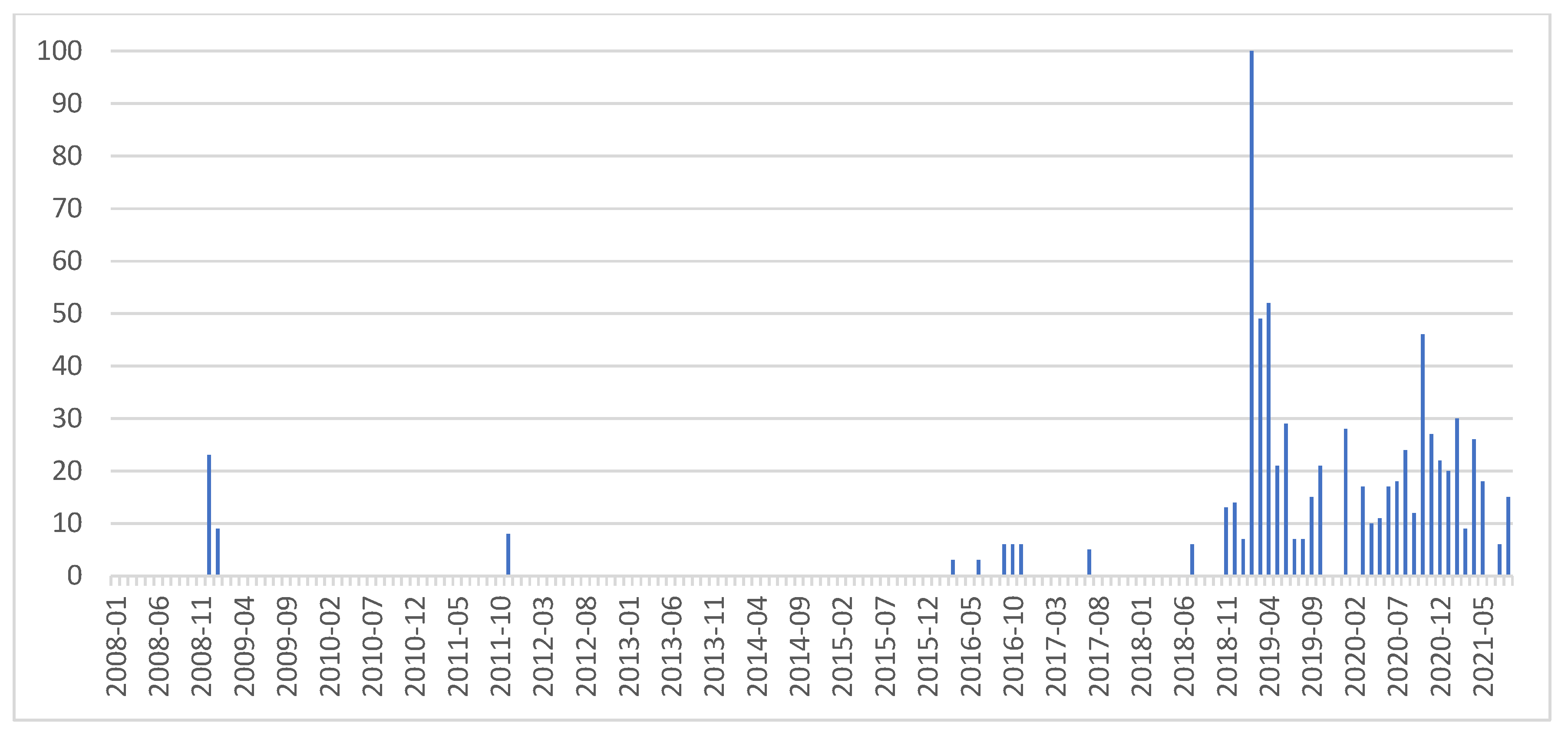
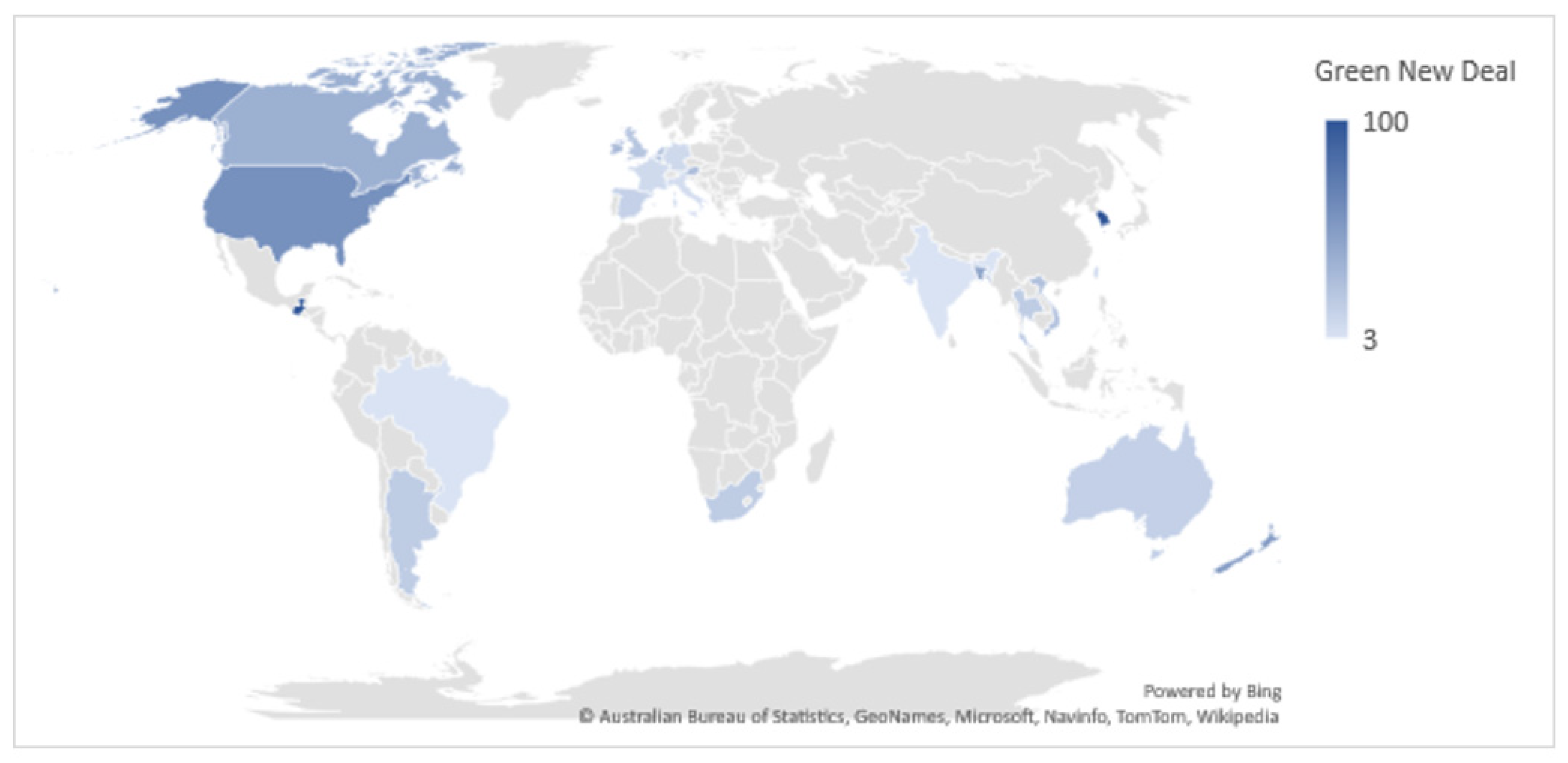
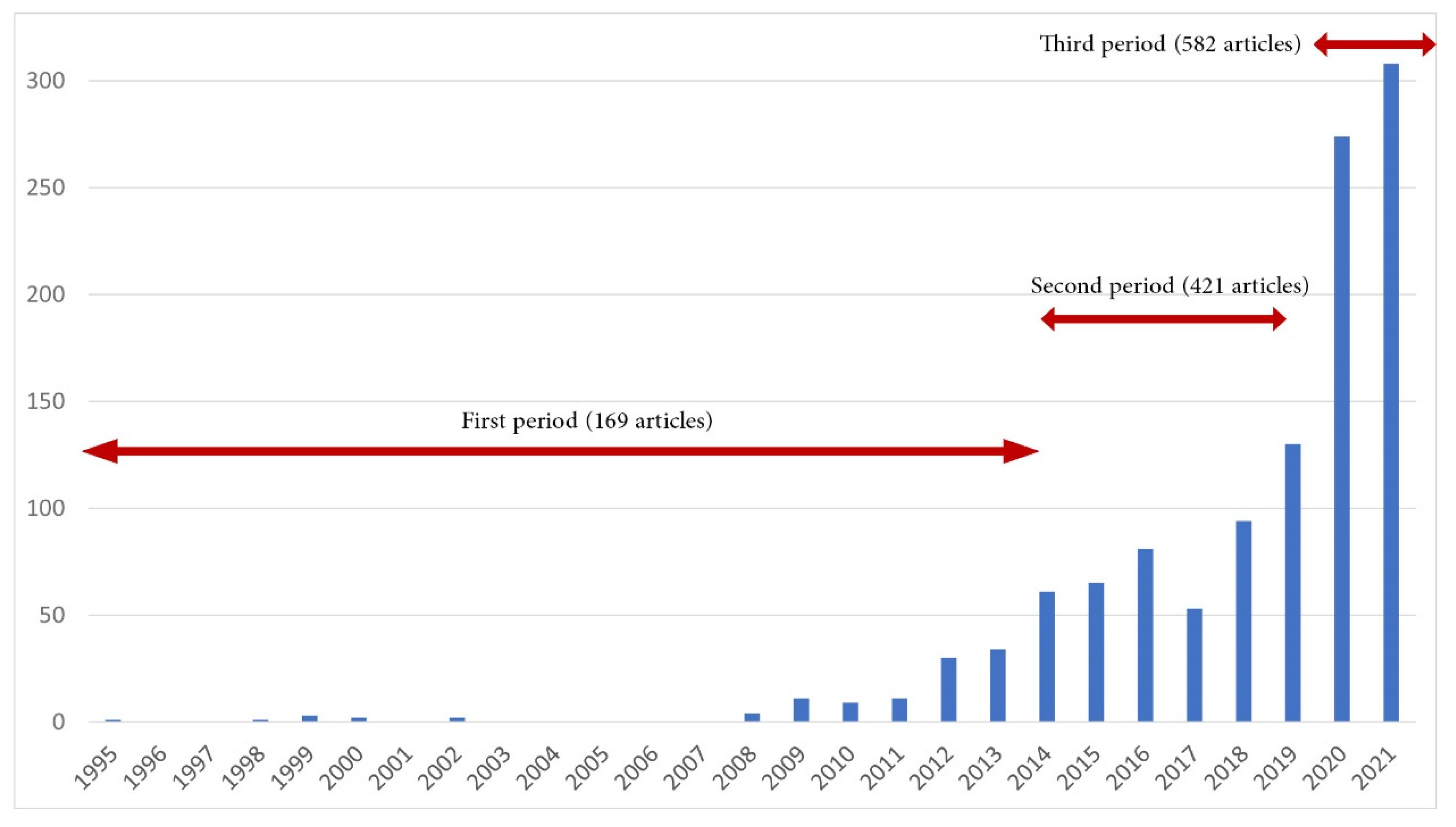


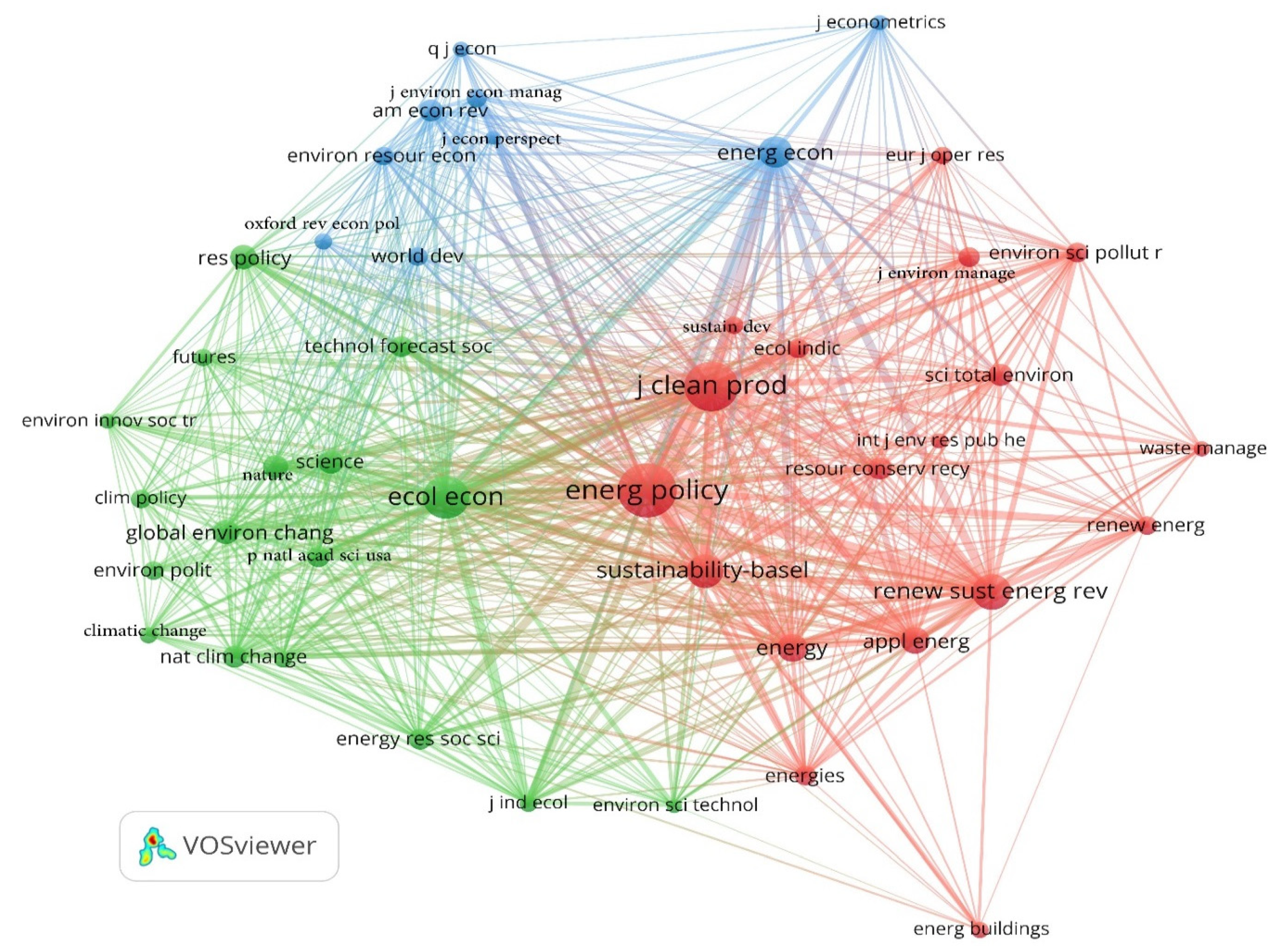
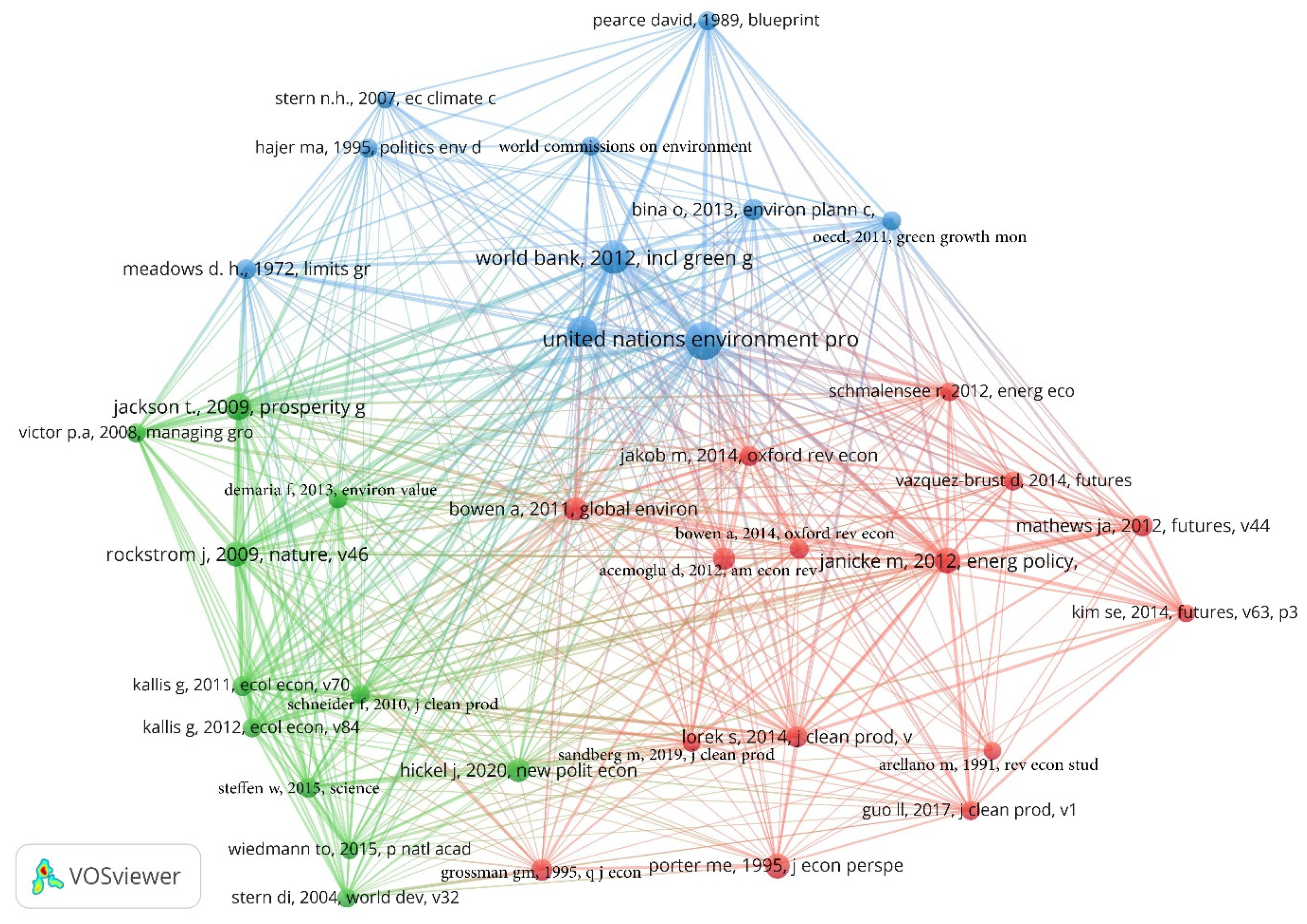
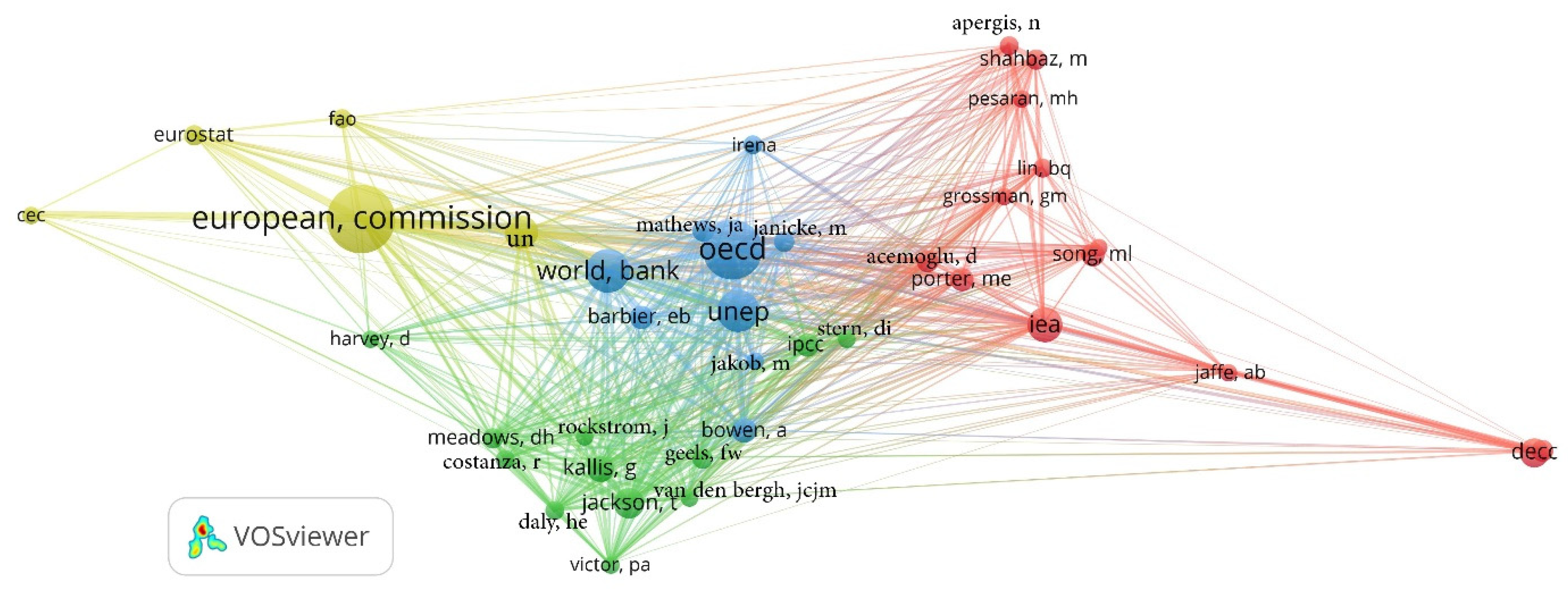


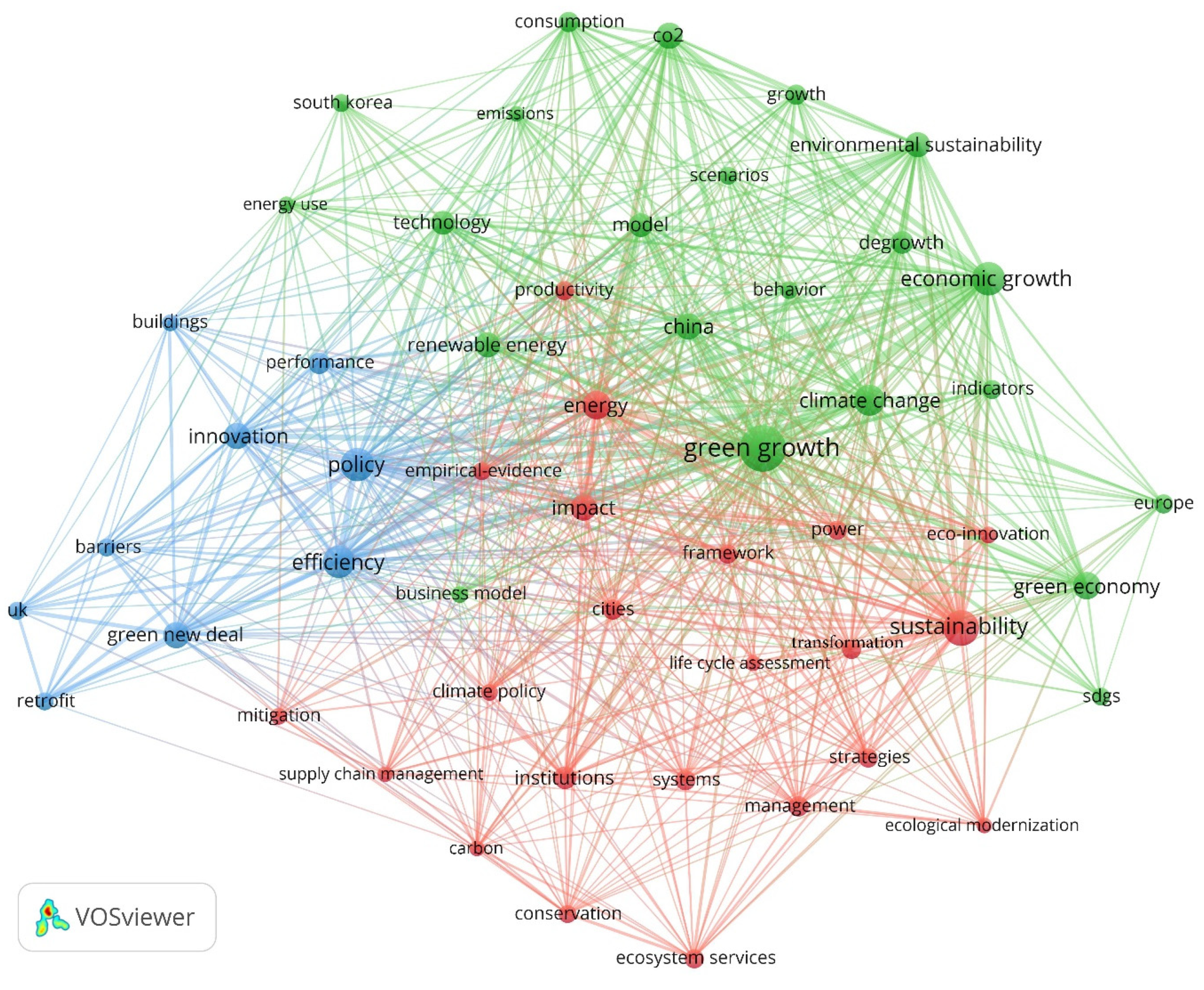
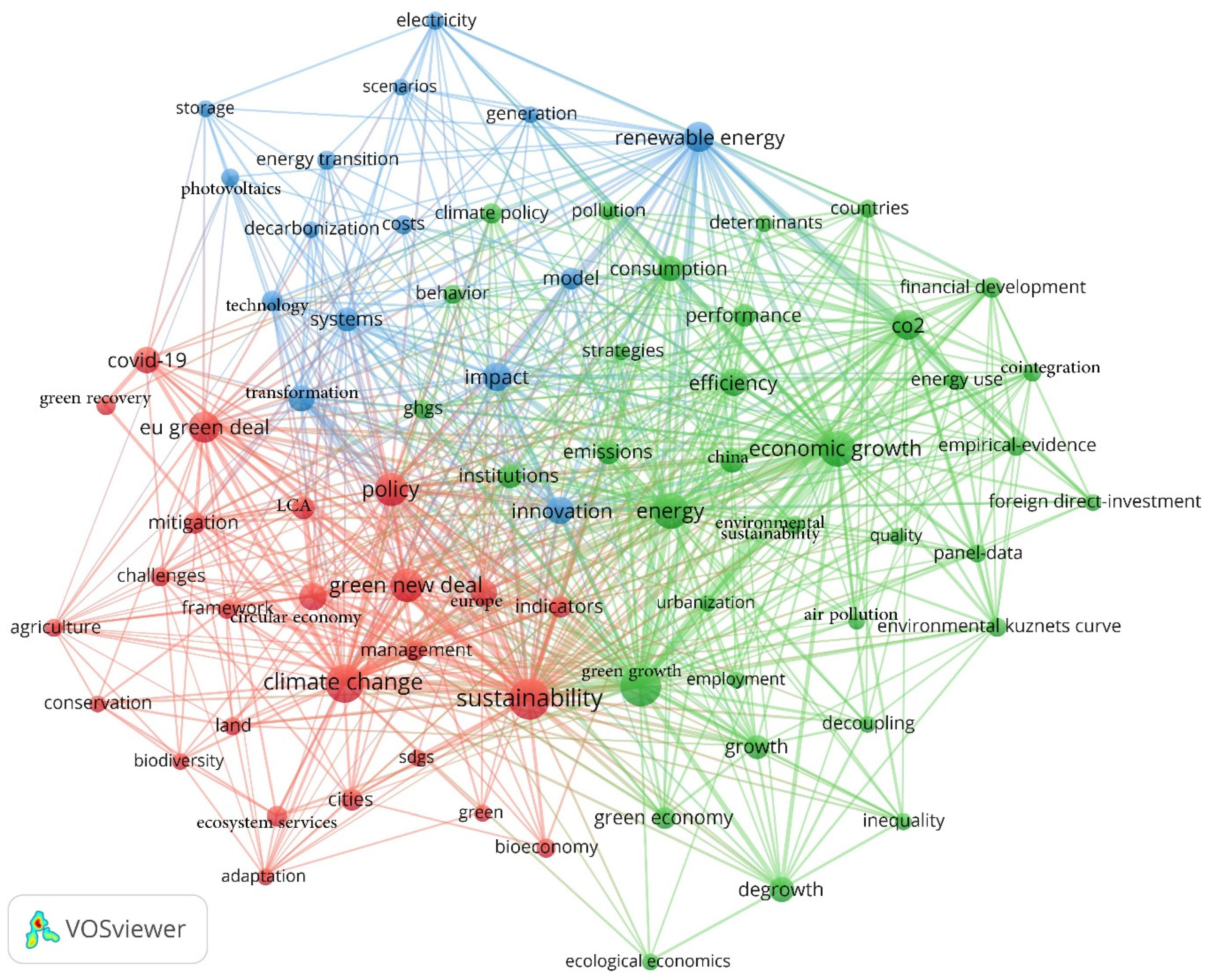
| Country | Name of Policy | Year Proposed | Source |
|---|---|---|---|
| Canada | Pact for a Green New Deal | 2019 | [27] |
| United Kingdom | Green Recovery Act | 2019 | London Assembly [28] |
| South Korea | Green New Deal | 2020 | Chowdhury [29] |
| The European Union | European Green New Deal | 2019 | European Commission [15] |
| China | Ecological Civilization | 2020 | Paszak [30] |
| United States of America | Green New Deal | 2019 | Congress [14] |
| Mexico | Green New Deal | 2020 | Moreno-Brid and Gallagher [31] |
| Singapore | Green Plan | 2021 | Government of Singapore [32] |
| Organizations | Year | Source |
|---|---|---|
| The Climate Mobilization | 2017 | The Climate Mobilization [35] |
| The European Green Party | 2006 | Green Party [36] |
| The Green-European Free Alliance | 2011 | The Greens/EFA [37] |
| The Democracy in Europe Movement 2025 | 2019 | DiEM25 [38] |
| Green Party of the United States | 2006 | Green Party of the United States [39] |
| Heinrich Böll Foundation | 2009 | French, et al. [40] |
| League of Conservation Voters | 2019 | League of Conservation Voters (LCV) [41] |
| The New Economic Foundation | 2008 | New Economics Foundation [42] |
| Open Democracy | 2018 | Robinson [43] |
| The United Nations Environmental Program | 2009 | UNEP [44] |
| The Global Marshall Plan Initiative | 2020 | Saha, et al. [45] |
| The United Nations Economic and Social Commission for Asia and the Pacific | 2012 | Ministry of Environment [46] |
| Title | Authors | Journal/Organization | No. of Citations | Link Strength |
|---|---|---|---|---|
| The environment and directed technical change | Daron Acemoglu Philippe Aghion Leonardo Bursztyn David Hemous | American Economic Review | 2243 | 54 |
| Some Tests of Specification for Panel Data: Monte Carlo Evidence and an Application to Employment Equations | Manuel Rellano Stephen Bond | Review of Economic Studies | 11,368 | 25 |
| The Green Economy and Sustainable Development: An Uneasy Balance? | Olivia Bina | SAGE Journals | 293 | 61 |
| The green growth narrative: Paradigm shift or just spin? | Alex Bowen Samuel Fankhauser | Global Environmental Change | 48 | 117 |
| What is degrowth? From an activist slogan to a social movement | Federico Demaria Francois Schneider Filka Sekulova Joan Martinez-Alier | Environmental Values | 693 | 86 |
| Domestic UK retrofit challenge: Barriers, incentives and current performance leading into the Green Deal | Mark Dowson Adam Poole David Harrison Gideon Susman | Energy Policy | 267 | 0 |
| European Commission | European Commission | 21 | 0 | |
| Economic growth and the environment | Gene M. Grossman Alan B. Krueger | The Quarterly Journal of Economics | 8497 | 47 |
| The interaction effects of environmental regulation and technological innovation on regional green growth performance | Ling Ling Guo Ying Qu Ming-Land Tseng | Journal of Cleaner Production | 138 | 51 |
| The Politics of Environmental Discourse: Ecological Modernisation and the Policy Process. | Maarten A. Hajer | Oxford University Press | 9423 | 47 |
| Is green growth possible? | Jason Hickel Giorgos Kallis | New Political Economy | 515 | 66 |
| Prosperity without growth? The transition to a sustainable economy | Tim Jackson | UK sustainable development commission | 1042 | 134 |
| Green growth, degrowth, and the commons | Michael Jakob Ottmar Edenhofer | Oxford Review of Economic Policy | 128 | 87 |
| “Green growth”: From a growing eco-industry to economic sustainability | Martin Jänicke | Energy Policy | 319 | 149 |
| In defence of degrowth | Giorgos Kallis | Ecological Economics | 1004 | 115 |
| The economics of degrowth | Giorgos Kallis Christian Kerschner Joan Martinez-Alier | Ecological Economics | 610 | 99 |
| A new approach to measuring green growth: Application to the OECD and Korea | Satbyul Estella Kim Ho Kim Yeora Chae | Futures | 71 | 58 |
| Sustainable consumption within a sustainable economy–beyond green growth and green economies | Sylvia Lorek Joachim H. Spangenberg | Journal of Cleaner Production | 556 | 106 |
| Green growth strategies—Korean initiatives | John A. Mathews | Futures | 129 | 68 |
| The limits to growth: The 30-year update | Dennis Meadows Jorgan Randers | Taylor and Francis | 4577 | 75 |
| Towards green growth | OECD | OECD | 79 | 171 |
| Towards green growth: Monitoring progress | OECD | OECD | 12 | 87 |
| Blueprint 1: for a green economy | David Pearce Anil Markandya Edward Barbier | Francis and Taylor | 4997 | 67 |
| Toward a New Conception of the Environment-Competitiveness Relatinship | Porte Me | Journal of Economics Perspectives | 34 | 39 |
| A safe operating space for humanity | Johan Rockström, Will Steffen Jonathan A. Foley | Nature | 10,911 | 127 |
| Green growth or degrowth? Assessing the normative justifications for environmental sustainability and economic growth through critical social theory | Maria Sandberg Kristian Klockars KristofferWilén | Journal of Cleaner Production | 85 | 56 |
| From “Green Growth” to sound policies: An overview | Richard Schmalensee | Energy Economics | 107 | 76 |
| Crisis or opportunity? Economic degrowth for social equity and ecological sustainability. Introduction to this special issue | François Schneider Giorgos Kallis Joan Martinez-Aliera | Journal of Cleaner Production | 1116 | 108 |
| Planetary boundaries: Guiding human development on a changing planet | Will Steffen Katherine Richardson Johan Rockström Sarah E. Cornell Ingo Fetzer Elena M. Bennett Reinette Biggs Stephen R. Carpenter Wim De Vries Cynthia A. De Wit Carl Folke Dieter Gerten Jens Heinke Georgina M. Mace Linn M. Persson Veerabhadran Ramanathan Belinda Reyers Sverker Sörlin | Science | 7611 | 70 |
| The rise and fall of the environmental Kuznets curve | David I Stern | World Development | 3587 | 53 |
| The economics of climate change: the Stern review | Nicholas Stern Nicholas Herbert Stern | Cambridge University Press | 1705 | 36 |
| Towards a Green Economy: Pathways to Sustainable Development and Poverty Eradication—A Synthesis for Policy Makers | UNEP | UNEP | 259 | 254 |
| Managing the transition to critical green growth: The ‘Green Growth State’ | Diego Vazquez-Brust Alastair M. Smith Joseph Sarkis | Futures | 60 | 55 |
| Managing without growth: slower by design, not disaster | Peter A. Victor | Edward Elgar Publishing | 1291 | 76 |
| The material footprint of nations | Thomas O. Wiedmann Heinz Schandl Manfred Lenzen Daniel Moran Sangwon Suh James West Keiichiro Kanemoto | Proceedings The National Academy of Sciences of the United States of America | 1235 | 79 |
Publisher’s Note: MDPI stays neutral with regard to jurisdictional claims in published maps and institutional affiliations. |
© 2021 by the authors. Licensee MDPI, Basel, Switzerland. This article is an open access article distributed under the terms and conditions of the Creative Commons Attribution (CC BY) license (https://creativecommons.org/licenses/by/4.0/).
Share and Cite
Allam, Z.; Sharifi, A.; Giurco, D.; Sharpe, S.A. On the Theoretical Conceptualisations, Knowledge Structures and Trends of Green New Deals. Sustainability 2021, 13, 12529. https://doi.org/10.3390/su132212529
Allam Z, Sharifi A, Giurco D, Sharpe SA. On the Theoretical Conceptualisations, Knowledge Structures and Trends of Green New Deals. Sustainability. 2021; 13(22):12529. https://doi.org/10.3390/su132212529
Chicago/Turabian StyleAllam, Zaheer, Ayyoob Sharifi, Damien Giurco, and Samantha A. Sharpe. 2021. "On the Theoretical Conceptualisations, Knowledge Structures and Trends of Green New Deals" Sustainability 13, no. 22: 12529. https://doi.org/10.3390/su132212529
APA StyleAllam, Z., Sharifi, A., Giurco, D., & Sharpe, S. A. (2021). On the Theoretical Conceptualisations, Knowledge Structures and Trends of Green New Deals. Sustainability, 13(22), 12529. https://doi.org/10.3390/su132212529









